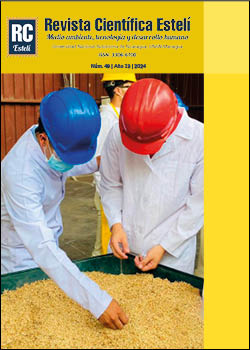Slowly changing dimensions in data warehouses: an analysis through literature review
DOI:
https://doi.org/10.5377/esteli.v13i49.17890Keywords:
Data Warehouses, Slowly Changing Dimensions (SCD), Modeling Strategies, Data Management, Decision MakingAbstract
This literature review article examines the impact and challenges posed by slowly changing dimensions (SCDs) in the context of Data Warehouses. It highlights how SCDs present unique challenges for data management and business decision making, with a focus on the need to maintain up-to-date and consistent historical data. In addition, a variety of modeling strategies used by various authors to circumvent these obstacles have been discussed, including the Kimball and Ross (2013) approach, as well as approaches such as Temporary Data Warehouses (TDW) and an emphasis on “Extract, Transform, and Load” (ETL). Each strategy is tailored to different business and data needs, offering valuable solutions to effectively address the SCD challenge and improve data quality in Data Warehouses. This study provides valuable insights for future research and practice, highlighting how strategic SCD management can empower informed decision making in the era of business analytics.
Downloads
References
Alsahfi, T., Almotairi, M., & Elmasri, R. (2020). A survey on trajectory Data Warehouse. Spatial Information Research(28), 53-66. doi:https://doi.org/10.1007/s41324-019-00269-x
Codd, E. F. (1970). A relational model of data for large shared data banks. Communications of the ACM, 13(6), 377–387. Obtenido de https://www.seas.upenn.edu/~zives/03f/cis550/codd.pdf
Faisal, S., & Sarwar, M. (2014). Handling slowly changing dimensions in data warehouses. Journal of Systems and Software(94), 151-160. doi:https://doi.org/10.1016/j.jss.2014.03.072
Golfarelli, M., & Rizzi, S. (2009). A Survey on Temporal Data Warehousing. International. Journal of Data Warehousing and Mining, 5(1), 1–17. doi:https://doi.org/10.4018/jdwm.2009010101
Golfarelli, M., & Rizzi, S. (2011). Temporal Data Warehousing: Approaches and Techniques. En D. Taniar, & L. Chen, Integrations of Data Warehousing, Data Mining and Database Technologies: Innovative Approaches (págs. 1-18). IGI Global. doi:https://doi.org/10.4018/978-1-60960-537-7.ch001
Guirao-Goris, J. A., Olmedo Salas, Á., & Ferrer Ferrandis, E. (2008). El artículo de revisión. Revista iberoamericana de enfermería comunitaria, 1(1), 1-25. Obtenido de https://www.researchgate.net/publication/268518751_El_articulo_de_revision
Gupta, A., & A., S. (2020). A Comprehensive Survey to Design Efficient Data Warehouse for Betterment of Decision Support Systems for Management and Business Corporates. International Journal of Management (IJM), 11(7), 463-471. Obtenido de https://iaeme.com/MasterAdmin/Journal_uploads/IJM/VOLUME_11_ISSUE_7/IJM_11_07_044.pdf
Gupta, A., & Sahayadhas, A. (2020). Proposed Techniques to Optimize the DW and ETL Query for Enhancing data warehouse efficiency. 5th International Conference on Computing, Communication and Security (ICCCS) (págs. 1-5). Patna: IEEE. Obtenido de https://ieeexplore.ieee.org/stamp/stamp.jsp?tp=&arnumber=9276824&isnumber=9276491
Hernández, R., Fernández, C., & Baptista, M. d. (2014). ¿En qué consiste la revisión analítica de la literatura? En R. Hernández Sampieri, C. Fernández Collado, & M. d. Baptista Lucio, Metodología de la investigación (6° ed.) (pág. 61). México D.F: McGraw Hill Interamericana Editores S.A. de C.V.
Hernández, R., Fernández, C., & Baptista, P. (2014). Concepción o elección del diseño. En R. Hernández, C. Fernández, & P. Baptista, Metodología de la investigación (6° ed.) (pág. 127). México D.F: McGraw Hill Interamericana Editores S.A. de C.V.
Hernández, R., Fernández, C., & Baptista, P. (2014). Definición del alcance de la investigación que se realizará: exploratorio, descriptivo, correlacional o explicativo. En R. Hernández, C. Fernández, P. Baptista, & S. D. INTERAMERICANA EDITORES (Ed.), Metodología de la Investigación (6° ed.) (pág. 90). México D.F: McGraw Hill Interamericana Editores S.A. de C.V.
Inmon, W. H. (2005). Going from the Data Warehouse to the Operational Environment. En W. H. Inmon, Building the Data Warehouse (4ta ed., pág. 117). Nueva Jersey: Wiley.
Kimball, R. (2008). Slowly Changing Dimensions. DM Review, 18(29), 1-9. Obtenido de https://www.proquest.com/scholarly-journals/slowly-changing-dimensions/docview/214686457/se-2?accountid=171676
Kimball, R., & Ross, M. (2013). The Data Warehouse Toolkit: The Definitive Guide to Dimensional Modeling (3ra ed.). Indianapolis: Wiley.
Liu, Q., Feng, G., Tayi, G., & Tian, J. (Abril de 2021). Managing Data Quality of the Data Warehouse: A Chance-Constrained Programming Approach. Information Systems Frontiers, Springer, 23(2), 375–389. doi:https://doi.org/10.1007/s10796-019-09963-5
Moody, D. L., & Kortink, M. A. (2000). From Enterprise Models to Dimensional Models: A Methodology for Data Warehouse and Data Mart Design. Proceedings of the Second Intl. Workshop on Design and Management of Data Warehouses (págs. 1-12). Estocolmo: DMDW 2000. Obtenido de https://ceur-ws.org/Vol-28/paper5.pdf
Phungtua-Eng, T., & Chittayasothorn, S. (2022). Information Integration and Multiple Slowly Changing Dimensions Modeling. ICCMS ‘22: Proceedings of the 14th International Conference on Computer Modeling and Simulation, (págs. 214-222). New York: Association for Computing Machinery. doi:https://doi.org/10.1145/3547578.3547611
Rahayu, G. P., & Gunawan, R. (2013). Penerapan Slowly Changing Dimensions untuk Mendukung Pembentukan Dimensi Dinamis pada Data Warehouse (Studi Kasus: Dinas Kependudukan dan Pencatatan Sipil Kabupaten XYZ). Seminar Nasional Aplikasi Teknologi Informasi (SNATI), 33-38. Obtenido de https://journal.uii.ac.id/Snati/article/view/3062/2822
Singh, A., & Pandey, S. P. (2021). Study of Slowly Changing Dimension to Dependent Data Mart to Manage Finance Data. International Journal of Scientific Research in Computer Science, Engineering and Information Technology, 7(6), 190-195. doi:https://doi.org/10.32628/CSEIT217657
Singh, B. (2006). Implementation of a solution to the slowly changing dimension (SCD) data warehouse consistency problem using extract transform and load (ETL) technology. Northridge: California State University. Obtenido de https://scholarworks.calstate.edu/downloads/4t64gs61v
Singh, R., & Singh, K. (Mayo de 2010). A Descriptive Classification of Causes of Data Quality Problems in Data Warehousing. IJCSI International Journal of Computer Science, 7(2), 41-50. Obtenido de https://courseware.cutm.ac.in/wp-content/uploads/2020/06/Descriptive-Classification.pdf
Vaisman, A., & Zimányi, E. (2019). Mobility Data Warehouses. International Journal of Geo-Information, 8(4), 170. doi:https://doi.org/10.3390/ijgi8040170
Yang, Q., Ge, M., & Helfert, M. (2019). Analysis of Data Warehouse Architectures: Modeling and Classification. Proceedings of the 21st International Conference on Enterprise Information Systems - Volume 2: ICEIS (págs. 604-611). Creta: SciTePress. doi: https://doi.org/10.5220/0007728006040611
Downloads
Published
Issue
Section
License
Copyright (c) 2024 Revista Científica Estelí

This work is licensed under a Creative Commons Attribution-NonCommercial-ShareAlike 4.0 International License.

